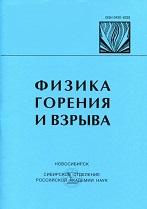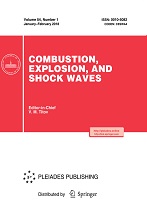|
This article is cited in 7 scientific papers (total in 7 papers)
Gasdynamic model of dilute two-phase combustion fields
A. L. Kuhla, K. Balakrishnanb
a Lawrence Livermore National Laboratory, Livermore, California, USA
b Lawrence Berkeley National Laboratory, Berkeley, California, 94720, USA
Abstract:
A gasdynamic model of two-phase combustion fields is proposed. The model is based on an extension of our dilute heterogeneous-continuum formulation, where now the particle phase is modeled thermodynamically as a particle gas (with a pressure $p_2$, temperature $T_2$, and internal energy $u_2$, given by the kinetic theory for hard spheres with $\gamma_2$ = 5/3), thereby, resulting in particle gas conservation laws for mass, momentum, and total energy. The particles also possess a thermal storage capacity, expressed in terms of an internal energy of the solid $e_s=c_s T_s$ with its own temperature $T_s$, and the corresponding energy conservation law. The consequence of this formulation is that both phases are hyperbolic, but decoupled; so each phase has it own complete set of eigenvalues and eigenvectors. The conservation laws for each phase can be integrated with a high-order Godunov scheme. Phases are coupled only through drag, heat, and mass transfer. The model is used to simulate aluminum particle combustion in a shock-dispersed-fuel explosion. Taking advantage of the point symmetry inherent in this problem, the flow field is azimuthally averaged in $\theta$ and $\varphi$ directions to extract the mean and root-mean-square radial profiles of the thermodynamic fields, velocity fields, and reaction zone profiles. We find that the particle gas pressure influences the flow only during the initial phase of particle acceleration: as the compaction wave moves through the powder, followed by the rarefaction wave from the free surface. Thereafter, the particle pressure decays rapidly and particle accelerations are dominated by drag. Nevertheless, this seems to affect the dispersion process because the combustion cloud shape is somewhat different from previous results.
Keywords:
combustion, two-phase medium, gasdynamic model, aluminum.
Received: 18.11.2011
Accepted: 03.02.2012
Citation:
A. L. Kuhl, K. Balakrishnan, “Gasdynamic model of dilute two-phase combustion fields”, Fizika Goreniya i Vzryva, 48:5 (2012), 59–76; Combustion, Explosion and Shock Waves, 48:5 (2012), 544–560
Linking options:
https://www.mathnet.ru/eng/fgv1037 https://www.mathnet.ru/eng/fgv/v48/i5/p59
|


| Statistics & downloads: |
| Abstract page: | 35 |
|





 Contact us:
Contact us: Terms of Use
Terms of Use
 Registration to the website
Registration to the website Logotypes
Logotypes








 Citation in format
Citation in format 
